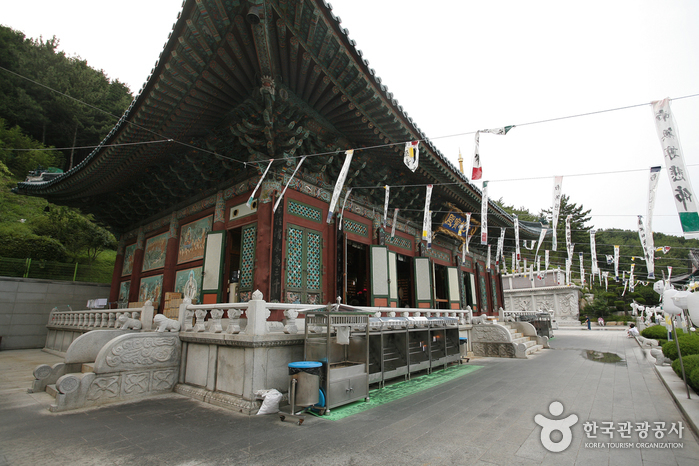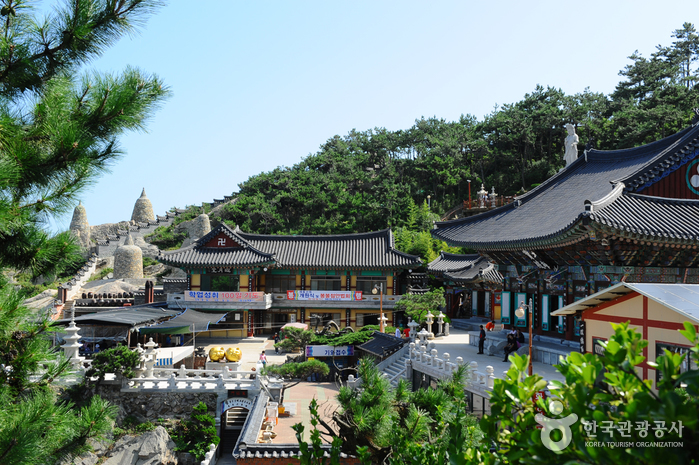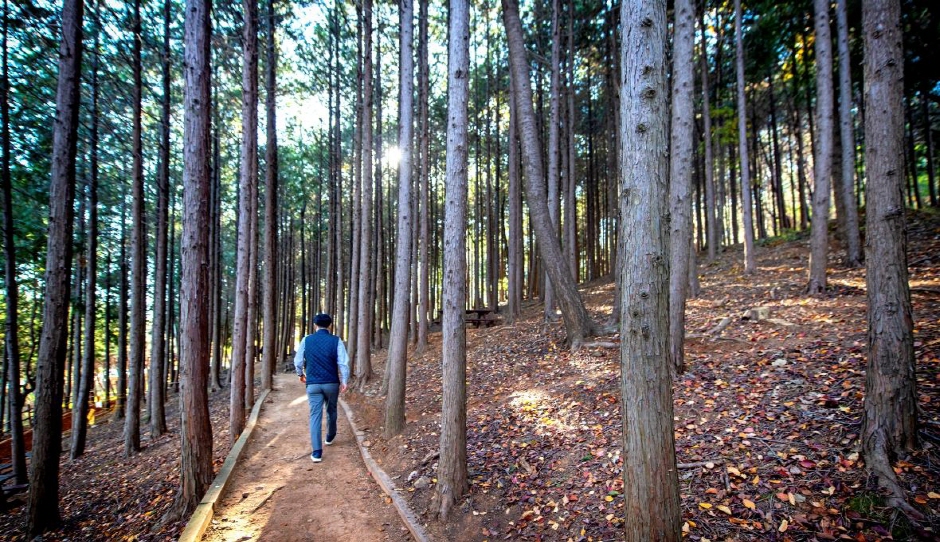Sinseondae Cliff (신선대 (부산))
8.0Km 2019-01-16
6, Sinseon-ro 303beon-gil, Nam-gu, Busan
+82-51-253-8253
Stretched out from Hwangryeongsan Mountain, Sinseondae Cliff is namely the most popular viewing spotl ocated in Busan's coastal area. Thanks to its geological location, the Sinseondae commends imcomparable ocean vista over many other small islets scattered around the bay area. The site is 4,121.707 ㎥, fairly flat and even therefore a perfect place for visitors to stroll around the area. An old folktale has it that, the name 'sinseon' (or Taoist in English) was given because the sacred people came to the mountain to rest and play, attracted by its spectacular view. The area has been highly appreciated by visitors for some hundreds of decades, and a documentary from one notable scholar from the Silla Era, Choi Chi-won, testifies the impressive looks from during his time.
Samgwangsa Temple Lantern Festival (삼광사 연등축제)
8.0Km 2021-07-23
29-7, Choeupcheon-ro 33beon-gil, Busanjin-gu, Busan
• 1330 Travel Hotline: +82-2-1330 (Korean, English, Japanese, Chinese) • For more info: +82-51-808-7111
Samgwangsa Temple annually holds its famous lantern festival, with over 40,000 lanterns to celebrate the birthday of Buddha. Visitors can see lanterns in a variety of colors and formations, including a tunnel, along with various events.
Samgwangsa Temple (삼광사)
8.0Km 2025-02-06
77 Choeupcheon-ro 43beon-gil, Busanjin-gu, Busan
+82-51-808-7111
Samgwangsa Temple is a Buddhist temple located on the slopes of Baegyangsan Mountain in downtown Busan. It houses various structures including the Daeungbojeon Hall, Bell Pavilion, and the Daebotap Tower, which stands at a x_height of 30 meters. The Daebotap Tower enshrines Buddha's relic brought from Tibet, Myanmar, and India. The temple offers different types of temple stays such as one-day, relaxation-oriented, and experiential stays. Visitors can participate in temple etiquette, tea ceremony experiences, 108 prostrations and meditation, Buddhist services, formal meal, and traditional cultural experiences tailored for foreigners.
Skyline Luge Busan (스카이라인 루지(부산))
8.1Km 2025-04-15
205 Gijanghaean-ro, Gijang-gun, Busan
Skyline Luge was first invented 32 years ago in Rotorua, New Zealand. It is currently a popular sport, with over 40 million rides recorded worldwide. Now, lugin facilciities are operated in six regions worldwide, including Busan. Skyline Luge Busan is a representative outdoor experiential amusement facility at Osiria Theme Park in Dongbusan. It has various auxiliary facilities with the beautiful sea as a backdrop and is a popular activity for the whole family. Take the Skyride lift o the starting point, get on the specially designed luge cart for down riding, and enjoy a thrilling 2.4-kilometer ride down from four tracks.
Fisheries Science Museum (수산과학관 (부산))
8.2Km 2021-07-20
216, Gijanghaean-ro, Gijang-gun, Busan
+82-51-720-3061
The Fisheries Science Museum, Korea's first science institute of its kind, was established on May 26, 1997 in order to promote maritime science and technology to the public. The museum was opened after six years of effort by the National Fisheries Science Institute in preparing research and materials regarding marine resources, the fishing industry, fishery and fish farm technology and equipment, taxidermied fish specimens, sea life species, and others. There are a total of 15 separate areas with over 7,400 exhibition items, and even an actual right whale skeleton on display, as well as a room where visitors can learn how to operate a marine vessel.
Haedong Yonggungsa Temple (해동 용궁사(부산))
8.2Km 2025-04-15
86 Yonggung-gil, Gijang-gun, Busan
Haedong Yonggungsa Temple is situated on the coast of the north-eastern portion of Busan. This superb attraction offers visitors the rare find of a temple along the shore line as most temples in Korea are located in the mountains. Haedong Yonggungsa Temple was first built in 1376 by the great Buddhist teacher known as Naong during the Goryeo dynasty.
The main sanctuary of the temple was reconstructed in 1970 with careful attention paid to the colors that were traditionally used in such structures. On the right-hand side, inside a cave, is a uniquely designed Buddhist sanctum, while situated just in front of the main sanctuary is a three-story pagoda with four lions. The four lions symbolize joy, anger, sadness, and happiness. Other special sites at the temple are the 108 stairs and stone lanterns lining the rocky landscape. After going down the 108 steps, one will be delighted with the beauty of the temple. Midway down the 108 steps one can stop and enjoy the calming sounds of the waves, and view the majestic sunrise.
CU - Jangjeon Oncheoncheon-ro Branch [Tax Refund Shop] (cu장전온천천로점)
8.3Km 2024-06-27
127, Jangjeononcheoncheon-ro, Geumjeong-gu, Busan
-
Olive Young - Busan Bugok DI Branch [Tax Refund Shop] (올리브영 부산부곡DI점)
8.3Km 2024-06-27
1722, Jungang-daero, Geumjeong-gu, Busan
-
ER NC Department Store - Busan Branch [Tax Refund Shop] (ER NC백화점 부산대)
8.4Km 2024-04-23
2, Busandaehak-ro 63beon-gil, Geumjeong-gu, Busan
-
Ttangmoesan Mountain (땅뫼산)
8.6Km 2024-02-26
260-1 Oryundae-ro, Geumjeong-gu, Busan
The Ttangmoesan Mountain Forest Trail, wrapping around the Hoedong Reservoir, is distinguished by its red clay path. This trail spans 1.7 kilometers and can be comfortably completed in approximately thirty minutes at a relaxed pace. As you stroll through the lush cypress forest, the cool sensation of the red clay is enjoyable under bare feet. The journey along forest paths and wooden deck walkways also reveals a variety of trees native to the lake marsh environment.




![ER NC Department Store - Busan Branch [Tax Refund Shop] (ER NC백화점 부산대)](http://tong.visitkorea.or.kr/cms/resource/25/2889325_image2_1.jpg)

 English
English
 한국어
한국어 日本語
日本語 中文(简体)
中文(简体) Deutsch
Deutsch Français
Français Español
Español Русский
Русский